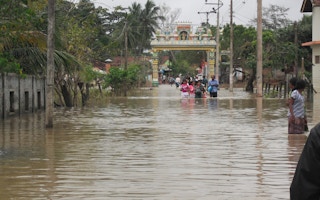A risk index released at the annual climate summit in the Polish city of Katowice shows that countries in South Asia are among the most vulnerable globally to the impacts of climate change.
India has been ranked the 14th most vulnerable nation in a list topped by Puerto Rico, which was ravaged by Hurricane Maria in 2017.
Sri Lanka was in second place after Puerto Rico. Nepal was ranked the world’s fourth most vulnerable country in this latest edition of the index, while Bangladesh was ranked ninth.
In 2017 alone, there were 2,726 deaths in India that were directly related to extreme weather-related events — heat waves, storms, floods and droughts.
India suffered an economic loss of about USD 13.8 billion in the year, the Global Climate Risk Index 2019 said.
Between 1998 and 2017, more than 526,000 people died worldwide and there were losses of USD 3.47 trillion as a result of more than 11,500 extreme weather events, said the index report prepared by Berlin-based environmental organisation Germanwatch.
Globally, 11,500 people died because of extreme weather events and economic damages totalled some USD 375 billion, it said.
The 2019 index analyses the extent to which countries and regions have been affected by impacts of weather-related loss from such events.
The most recent data available — for 2017 and from 1998 to 2017 — were taken into account while preparing the index.
“
Poor countries are hardest hit. But extreme weather events also threaten the further development of upper middle-income countries and can even overburden high-income countries.
David Eckstein, lead author, Global Climate Risk Index 2019
Disastrous storms
“Recent storms with intensity levels never seen before have had disastrous impacts,” said David Eckstein of Germanwatch, lead author of the index.
“Poor countries are hardest hit. But extreme weather events also threaten the further development of upper middle-income countries and can even overburden high-income countries.”
Massive rainfall led to floods across Nepal, Bangladesh and India, which affected more than 40 million people. As many as 200 people lost their lives in these three countries and millions were displaced throughout the region, Germanwatch said.
The floods spread across the foothills of the Himalayas and brought landslides, destroying tens of thousands of houses, vast areas of farmland and roads.
Nepal experienced flash floods and landslides in August 2017 across the southern border with India, leading to USD 600 million in damages.
In many of the countries most affected by natural disasters in the past year, unusually extreme rainfall was followed by severe floods and landslides.
This was the case in Sri Lanka, where exceptionally heavy rain caused dramatic flooding that killed 200 people and left hundreds of thousands people homeless.
Impact highest in poorer countries
Germanwatch said it is the poorer countries that are most affected in its long-term index, as eight of the 10 countries most affected between 1998 and 2017 are developing economies.
The risk index was prepared by using the NatCatSERVICE database of the reinsurance company Munich Re and socioeconomic data of the International Monetary Fund.
It has said that there is increasing evidence on the link between El Niño events and global warming. The occurrence of El Niño, a warm current in the Pacific Ocean, affects the monsoon in South Asia, which is vital for the summer cropping season. The occurrence of such events could double in the future due to climate change, the report had said earlier.
The Australian meteorological department has predicted that there is evidence that El Niño is developing this year, which could have an adverse impact on Indian farming, which is already in the midst of a crisis.
Farmers have already taken to the streets protesting their dire situation at a politically crucial time because India is scheduled to hold national elections by May next year.
The ongoing climate summit “has to increase efforts to properly address loss and damage,” Eckstein said. “At present, it is a cross-cutting issue referenced throughout various negotiation streams, with significant risk of being omitted from final negotiation text.
Countries like Haiti, the Philippines, Sri Lanka and Pakistan are repeatedly hit by extreme weather events and have no time to fully recover. It is important to support these countries in climate change adaptation, but that is not sufficient. They need predictable and reliable financial support for dealing with climate-induced loss and damage as well.”
It is yet unclear how much progress the Katowice climate summit will make to address these challenges. The 24th Conference of Parties aims to prepare the rule book needed to implement the Paris Agreement.
It is uncertain how loss and damage due to the impacts of climate change will be taken up under the Paris Agreement.
This story was published with permission from The Third Pole. Read the full story.








